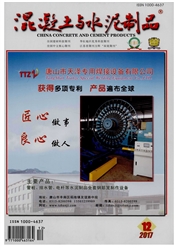

 中文摘要:
中文摘要:
以饱和石灰水为电解液,对外掺3%NaCl的混凝土圆柱体试件进行电化学除氯试验,研究了三种不同电流密度(1.0 A/m2、2.0 A/m2、3.0 A/m2)作用28d后混凝土中氯离子和钾、钠离子的分布规律。结果表明:电流密度越高时,在距离钢筋越近区域,混凝土中的残余氯离子含量越少;电流密度为2.0 A/m2和3.0A/m2时,可使混凝土中距离钢筋20mm范围内的氯离子含量均降低到水泥用量0.15%(占水泥质量)以下。在电化学除氯电场作用下,大量钾、钠离子向钢筋附近区域迁移和聚集,使混凝土试件内层钠离子含量达到最外层的4.8~17.3倍,钾离子含量达到最外层的3.8~17.5倍,从而增加了混凝土内部发生碱骨料反应破坏的风险,并导致部分水化产物分解,使混凝土与钢筋粘结力显著降低。
 英文摘要:
英文摘要:
Electrochemical chloride extraction (ECE) treatment is applied to cylindrical concrete specimens containing 3% NaCl by the weight of cement with saturated Ca (0H)2 solution as the electrolyte solution, and the distribution of chlo- ride, potassium and sodium ions in concrete specimens are studied after 28 days' ECE treatment with three different current densities (1.0 Mm2, 2.0 A/m2 and 3.0 A/m2). The results show that less residual chloride ions remain in concrete with a shorter distance to reinforced steel in the ECE treated specimen when a higher current density applied. The amount of chloride ions is reduced to less than 0.15 % (by the weight of cement) in 20 mm concrete portions near the steel for every specimen treated with current densities of 2.0 A/m2 and 3.0 A/m2. Under the external electric field of ECE treatment, a great quantity of potassium and sodium ions migrate and accumulate into the steel surrounding area. The amount of sodium ions in the inner layer concrete reaches 4.8 to 17.3 times of those in the external layer concrete and the amount of potassium ions in the inner layer concrete becomes 3.8 to 17.5 times of those in the external layer concrete after the ECE treatment. The risk of alkali-aggregate reaction attack is consequently increased in the inner concrete, and a small quantity of cement hydration products become decomposed, which is attributing to the bond strength between steel and concrete decreasing evidently.
 同期刊论文项目
同期刊论文项目
 同项目期刊论文
同项目期刊论文
 Electrochemical Changes of Pre-Corroded Steel Reinforced Concrete Due to Electrochemical Chloride Ex
Electrochemical Changes of Pre-Corroded Steel Reinforced Concrete Due to Electrochemical Chloride Ex 期刊信息
期刊信息
